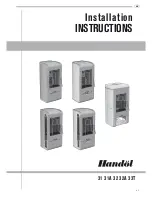
12 Termo JOHANNA
Roof
slope
(α)
(α)
(α)
(α)
Distance A
H
15°
1.00 m
30°
1.30 m
45°
2.00 m
60°
More than 1.85 m
2.60 m
Before connecting a heating stove to an existing chimney, in addition to complying with that
described above, make sure there are no openings or cracks where air could enter and cause a
temperature decrease affecting the draught.
Also make sure there are no hindrances caused by foreign bodies or a build-up of soot.
The first connection
section
leaving
the
stove
should
be
vertical, whereas the
flue connection to the
chimney (which goes
to the chimney cap)
must only enter by a
few cm, so as not to
reduce
the
cross
section of the flue.
If the flue is not
perpendicular to the
chimney,
it
is
advisable to make the
connection
with
special steel fittings
that allow a maximum
slope of 45°.
If the walls and ceiling are made of flammable materials, the parts in contact with the flue must be
suitably insulated. All connection joints must be carefully sealed, in particular where the connection
enters the flue.
If there are several heating stoves in the same home, each must have its own flue. It is inadvisable
to make openings in the flue for other appliances, since the draught could be negatively affected.
According to Standard UNI 7429, the chimney cap must meet several requirements; above all, it
must have a useful outlet cross section at least double that of the flue. It is also advisable to install
an "antiwind" cap that guarantees fume exhaust even in the presence of strong horizontal winds.
YES NO
NO YES YES
Fig 5 Horizontal winds
3– HEATING STOVE USE
Roof
slope
(α)
(α)
(α)
(α)
Distance B
H
15°
0.50 m
30°
0.50 m
45°
0.50 m
60°
Less than 1.85 m
0.50 m
NO
NO
YES
MAX 45°
Fig.4 stove - flue connection





































